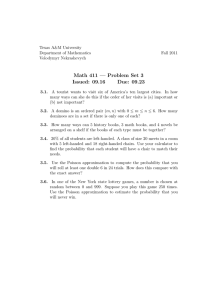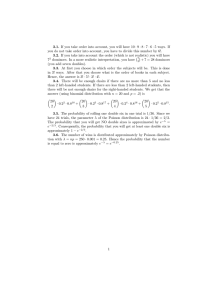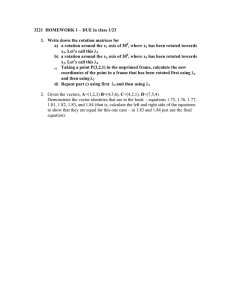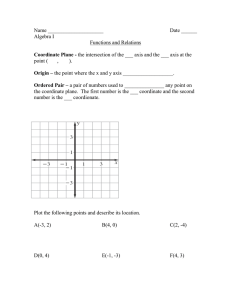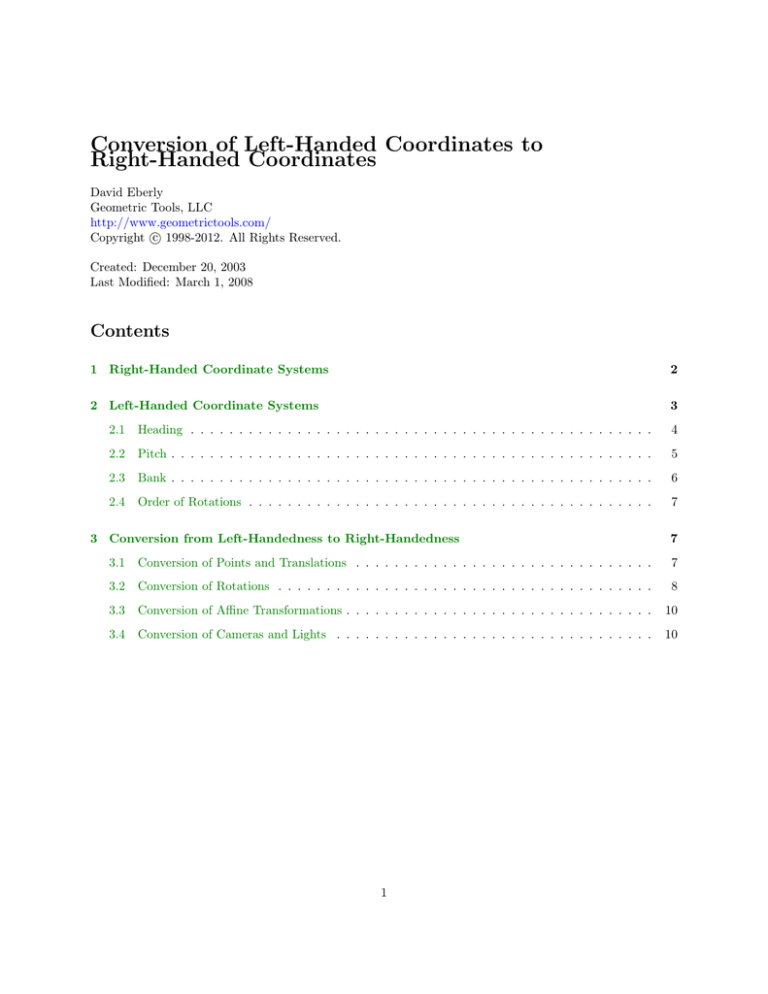
Conversion of Left-Handed Coordinates to
Right-Handed Coordinates
David Eberly
Geometric Tools, LLC
http://www.geometrictools.com/
c 1998-2012. All Rights Reserved.
Copyright Created: December 20, 2003
Last Modified: March 1, 2008
Contents
1 Right-Handed Coordinate Systems
2
2 Left-Handed Coordinate Systems
3
2.1
Heading . . . . . . . . . . . . . . . . . . . . . . . . . . . . . . . . . . . . . . . . . . . . . . . .
4
2.2
Pitch . . . . . . . . . . . . . . . . . . . . . . . . . . . . . . . . . . . . . . . . . . . . . . . . . .
5
2.3
Bank . . . . . . . . . . . . . . . . . . . . . . . . . . . . . . . . . . . . . . . . . . . . . . . . . .
6
2.4
Order of Rotations . . . . . . . . . . . . . . . . . . . . . . . . . . . . . . . . . . . . . . . . . .
7
3 Conversion from Left-Handedness to Right-Handedness
7
3.1
Conversion of Points and Translations . . . . . . . . . . . . . . . . . . . . . . . . . . . . . . .
7
3.2
Conversion of Rotations . . . . . . . . . . . . . . . . . . . . . . . . . . . . . . . . . . . . . . .
8
3.3
Conversion of Affine Transformations . . . . . . . . . . . . . . . . . . . . . . . . . . . . . . . .
10
3.4
Conversion of Cameras and Lights . . . . . . . . . . . . . . . . . . . . . . . . . . . . . . . . .
10
1
This document describes the process by which you convert data in a left-handed coordinate system to
that in a right-handed coordinate system. The data includes vertex locations, translational and rotational
transformations, camera location and orientation, and light location and orientation.
1
Right-Handed Coordinate Systems
A right-handed coordinate system is described as +Xr in the left direction, +Yr in the up direction, and +Zr
in the view direction. Figure 1.1 shows a typical representation.
Figure 1.1 A right-handed coordinate system. The coordinate names are subscripted with r to
stress the fact these are for the right-handed system. The +Zr axis is intend to have direction into
the plane of the page.
The origin of the system is (0, 0, 0). A point (x, y, z) is located relative to the origin by moving x units to
the left (when x > 0) or to the right (when x < 0), y units up (when y > 0) or down (when y < 0), and z
units away (when z > 0) or towards (when z < 0).
The placement of the axes in Figure 1.1 is based on wanting the Yr -axis to point upward and the Zr -axis to
point into the plane of the page. To make sure the coordinate system is right-handed, the only choice for
the Xr -axis is to point to the left. The direction of Xr is actually not relevant on its own. You may choose
Xr to point to the right, Yr to point up, and Zr to point out of the plane of the page. Or choose Xr to point
to the right, Yr to point down, and Zr to point into the plane of the page. For that matter, you may rotate
any of these configurations to any other configuration you like, but you still have a right-handed system.
Choose any of the coordinate directions you wish to be the up vector, choose any remaining direction to be
the view direction. You have only one choice for the third vector. If this is the world coordinate system you
are choosing for an application, you need only position and orient the camera in such a way that your view
of the world is what you expect! You can do this regardless of your convention for what is the up direction
and what is the view direction.
In this document, the rotation conventions for right-handed coordinates are that positive angles are associated
with counterclockwise rotations when viewing the system along the negative direction of the axis of rotation.
The rotation about the x-axis is
1
0
0
Rx (θ) = 0 cos(θ) − sin(θ)
(1)
0 sin(θ)
cos(θ)
2
The rotation about the y-axis is
Ry (θ) =
The rotation about the z-axis is
cos(θ)
0
0
1
− sin(θ)
0
0
cos(θ)
cos(θ) − sin(θ)
Rz (θ) = sin(θ)
0
2
sin(θ)
cos(θ)
0
0
(2)
0
1
(3)
Left-Handed Coordinate Systems
A left-handed coordinate system is described as +X` in the right direction, +Y` in the up direction, and +Z`
in the view direction. The prototypical modeling package that uses left-handed coordinates for all objects is
LightWave. The discussion here is effectively a description of LightWave’s conventions. Figure 2.1 shows a
typical representation.
Figure 2.1 A left-handed coordinate system. The coordinate names are subscripted with ` to stress
the fact these are for the left-handed system. The +Z` axis is intend to have direction into the plane
of the page.
The origin of the system is (0, 0, 0). A point (x, y, z) is located relative to the origin by moving x units to
the right (when x > 0) or to the left (when x < 0), y units up (when y > 0) or down (when y < 0), and z
units away (when z > 0) or towards (when z < 0).
Figure 2.1 also shows how coordinate axis rotations are defined in this left-handed system. The direction of
the X` axis is (1, 0, 0), the direction of the Y` axis is (0, 1, 0), and the direction of the Z` axis is (0, 0, 1). We
may conveniently store the direction vectors as the columns of the identity matrix,
1 0 0
I= 0 1 0
0 0 1
3
Notice that the first column is the right direction, the second column is the up direction, and the third
column is the view direction.
2.1
Heading
A rotation about the Y` -axis represents heading. In Figure 2.1, the direction shown by the arrow labeled
“heading” corresponds to a positive angle. If you are looking in the −Y` direction, a positive angle is
associated with a clockwise rotation. Figure 2.2 shows a view in the −Y` direction.
Figure 2.2 A view in the −Y` direction. A positive angle for heading is associated with a clockwise
rotation in the plane of X` and Z` .
The heading angle is θh and the figure illustrates a heading that is a positive angle (clockwise rotation).
The Z` axis is rotated to the Z`0 axis, the latter axis having direction (sh , 0, ch ) where sh = sin(θh ) and
ch = cos(θh ). The X` axis is rotated to the X`0 axis, the latter axis having direction (ch , 0, −sh ). The Y`
axis is unchanged by the rotation, so the rotated axis Y`0 is the same as the original one. Just as the identity
matrix columns are the original directions in the order right, up, and view, the rotated axes may be listed
as the columns of another matrix in the same order. This matrix is the heading matrix
ch 0 sh
H` (θh ) =
0 1 0
−sh 0 ch
Observe that the first column is the direction of the X`0 axis, the second column is the direction of the Y`0
(and Y` ) axis, and the third column is the direction of the Z`0 axis.
The heading matrix was introduced as a convenient way to store the directions of the rotated coordinate
axes. The matrix has double duty in that it may also be used to show how points (x, y, z) in the original
coordinate system are rotated to points (x0 , y 0 , z 0 ). Specifically,
x0
ch 0 sh
x
ch x + sh z
0
(4)
y =
0 1 0 y =
y
z0
−sh 0 ch
z
−sh x + ch z
The standard rules of matrix multiplication have been applied.
4
2.2
Pitch
A rotation about the X` axis represents pitch. In Figure 2.1, the direction shown by the arrow labeled “pitch”
corresponds to a positive angle. If you are looking in the −X` direction, a positive angle is associated with
a clockwise rotation. Figure 2.3 shows a view in the −X` direction.
Figure 2.3 A view in the −X` direction. A positive angle for heading is associated with a clockwise
rotation in the plane of Y` and Z` .
The pitch angle is θp and the figure illustrates a pitch that is a positive angle (clockwise rotation). The Z`
axis is rotated to the Z`0 axis, the latter axis having direction (0, −sp , cp ) where sp = sin(θp ) and cp = cos(θp ).
The Y` axis is rotated to the Y`0 axis, the latter axis having direction (0, cp , sp ). The X` axis is unchanged
by the rotation, so the rotated axis X`0 is the same as the original one. Just as the identity matrix columns
are the original directions in the order right, up, and view, the rotated axes may be listed as the columns of
another matrix in the same order. This matrix is the pitch matrix
1 0
0
P` (θp ) = 0 cp −sp
0 sp
cp
Observe that the first column is the direction of the X`0 (and X` ) axis, the second column is the direction of
the Y`0 axis, and the third column is the direction of the Z`0 axis.
The pitch matrix was introduced as a convenient way to store the directions of the rotated coordinate axes.
The matrix has double duty in that it may also be used to show how points (x, y, z) in the original coordinate
system are rotated to points (x0 , y 0 , z 0 ). Specifically,
x0
1 0
0
x
x
0
(5)
y = 0 cp −sp y = cp y − sp z
z0
0 sp
cp
z
sp y + cp z
The standard rules of matrix multiplication have been applied.
5
2.3
Bank
A rotation about the Z` axis represents bank. In Figure 2.1, the direction shown by the arrow labeled “bank”
corresponds to a positive angle. If you are looking in the −Z` direction, a positive angle is associated with
a clockwise rotation. Figure 2.4 shows a view in the −Z` direction.
Figure 2.4 A view in the −Z` direction. A positive angle for heading is associated with a clockwise
rotation in the plane of X` and Y` .
The bank angle is θb and the figure illustrates a bank that is a positive angle (clockwise rotation). The X`
axis is rotated to the X`0 axis, the latter axis having direction (cb , sb , 0) where sb = sin(θb ) and cb = cos(θb ).
The Y` axis is rotated to the Y`0 axis, the latter axis having direction (−sb , cb , 0). The Z` axis is unchanged
by the rotation, so the rotated axis Z`0 is the same as the original one. Just as the identity matrix columns
are the original directions in the order right, up, and view, the rotated axes may be listed as the columns of
another matrix in the same order. This matrix is the bank matrix
cb −sb 0
B` (θb ) = sb
cb 0
0
0 1
Observe that the first column is the direction of the X`0 axis, the second column is the direction of the Y`0
axis, and the third column is the direction of the Z`0 (and Z` ) axis.
The bank matrix was introduced as a convenient way to store the directions of the rotated coordinate axes.
The matrix has double duty in that it may also be used to show how points (x, y, z) in the original coordinate
system are rotated to points (x0 , y 0 , z 0 ). Specifically,
x0
cb −sb 0
x
cb x − sb y
0
(6)
y = sb
cb 0 y = sb x + cb y
0
z
0
0 1
z
z
The standard rules of matrix multiplication have been applied.
6
2.4
Order of Rotations
The order of application of heading, pitch, and bank is dependent on the graphics package at hand. LightWave specifies rotations only by a composition of coordinate axis rotations. Moreover, LightWave only tells
you the three angles: heading, pitch, and bank. It is important that you apply these in the correct order. In
particular, the composite rotation is R` = H` P` B` . LightWave uses the convention for transforming vectors,
R` v, where the vector v is a 3 × 1 column vector. Thus, LightWave applies bank first, pitch second, and
heading third.
3
Conversion from Left-Handedness to Right-Handedness
The simplest method for conversion is to flip the direction of one of the axes of the left-handed system. It
does not matter which one. The analysis here uses the flip of the z-axis direction. You may also flip the
direction of all three axes, but no sense in doing more work than you have to.
3.1
Conversion of Points and Translations
This is where the flip of the z-axis direction is obvious. A point (x, y, z) in the left-handed system is converted
to a point (x, y, −z) in the right-handed system. Figure 3.1 illustrates this in the xz-plane with the two
coordinate systems superimposed.
Figure 3.1 Conversion of a point in left-handed coordinates (subscripted with an `) to a point in
right-handed (subscripted with a r). Just change sign on the z-component.
The figure shows that the point in the left-handed coordinate system has a positive z component. In the
right-handed coordinate system, observe that the z component must be negative. In matrix-vector form, the
conversion from a left-handed point Q` to a right-handed point Qr is
x
1 0
0
x
Qr = y = 0 1
0 y = Sz Q`
−z
0 0 −1
z
7
where Sz is defined to be the diagonal matrix
1
Sz = Diag(1, 1, −1) = 0
0
0
1
0
0
0
−1
The translational component of a transformation is modified just as points are. The z component is negated.
Pseudocode for conversion of a point (or translation) is
Vector3 LH_Point(LH_X, LH_Y, LH_Z);
Vector3 RH_Point(LH_X, LH_Y, -LH_Z);
3.2
// left-handed coordinates of point
// right-handed coordinates of point
Conversion of Rotations
Conversion of Heading. Equation 4 shows that an input left-handed point Q` = (x, y, z) is transformed
by the heading matrix to an output left-handed point Q0` = (x0 , y 0 , z 0 ) by
x
ch 0 sh
x0
Q0` = y 0 =
0 1 0 y = H` Q`
z
−sh 0 ch
z0
In right-handed coordinates, both the input and output must have negated z components, so the transformation in the right-handed system is Qr = (x, y, −z) → (x0 , y 0 , −z 0 ) = Q0r , or
Q0r = Sz Q0` = Sz H` Q` = (Sz H` Sz )Qr
The heading matrix Hr in the right-handed system corresponding to the heading matrix H` in the left-handed
system is
Hr = Sz H` Sz
(7)
For a matrix M = [mij ] with 0 ≤ i ≤ 2 and 0 ≤ j ≤ 2, the operation Sz M Sz is equivalent to changing the
signs on m02 , m12 , m20 , and m21 .
Conversion of Pitch. Equation 5 shows that an input left-handed point Q` = (x, y, z) is transformed by
the pitch matrix to an output left-handed point Q0` = (x0 , y 0 , z 0 ) by
x0
1 0
0
x
Q0` = y 0 = 0 cp −sp y = P` Q`
z0
0 sp
cp
z
In right-handed coordinates, both the input and output must have negated z components, so the transformation in the right-handed system is Qr = (x, y, −z) → (x0 , y 0 , −z 0 ) = Q0r , or
Q0r = Sz Q0` = Sz P` Q` = (Sz P` Sz )Qr
8
The pitch matrix Pr in the right-handed system corresponding to the pitch matrix P` in the left-handed
system is
Pr = Sz P` Sz
(8)
Conversion of Bank. Equation 6 shows that an input left-handed point Q` = (x, y, z) is transformed by
the bank matrix to an output left-handed point Q0` = (x0 , y 0 , z 0 ) by
x
cb −sb 0
x0
Q0` = y 0 = sb
cb 0 y = B` Q`
z
0
0 1
z0
In right-handed coordinates, both the input and output must have negated z components, so the transformation in the right-handed system is Qr = (x, y, −z) → (x0 , y 0 , −z 0 ) = Q0r , or
Q0r = Sz Q0` = Sz B` Q` = (Sz B` Sz )Qr
The bank matrix Br in the right-handed system corresponding to the bank matrix B` in the left-handed
system is
Br = Sz B` Sz
(9)
The Composite Rotation. The left-handed composite rotation is R` = H` P` B` . The transformation of
Q` = (x, y, z) by R` to Q0` is
Q0` = RP Q`
In right-handed coordinates where Qr = (x, y, −z) = Sz Q` and Q0r = Sz Q0` , we have
Q0r = Sz Q0` = Sz RP Q` = (Sz RP Sz )Qr
The right-handed rotation Rr corresponding to the left-handed rotation R` is therefore,
Rr = Sz R` Sz
(10)
Pseudocode for the conversion of rotations is shown below. The equations for the rotations are (1), (2), and
(3).
// left-handed rotation angles
float LH_AngleH, LH_AngleP, LH_AngleB;
// left-handed coordinate rotation
Matrix3 LH_H((0,1,0), LH_AngleH);
Matrix3 LH_P((1,0,0), LH_AngleP);
Matrix3 LH_B((0,0,1), LH_AngleB);
matrices
// heading
// pitch
// bank
// left-handed composite rotation
Matrix3 LH_Rotate = LH_H * LH_P * LH_B;
// right-handed composite rotation
Matrix3 RH_Rotate = LH_Rotate;
9
RH_Rotate[0][2]
RH_Rotate[1][2]
RH_Rotate[2][0]
RH_Rotate[2][1]
3.3
=
=
=
=
-RH_Rotate[0][2];
-RH_Rotate[1][2];
-RH_Rotate[2][0];
-RH_Rotate[2][1];
Conversion of Affine Transformations
Let A` = [aij ] be a 3 × 3 matrix and let b` = [bi ] be a 3 × 1 vector for 0 ≤ i ≤ 2 and 0 ≤ j ≤ 2. The affine
transformation of Q` = (x, y, z) to Q0` = (x0 , y 0 , z 0 ) by A and b is given in matrix form by
Q0` = A` Q` + b`
The input and output points in right-handed coordinates are Qr = (x, y, −z) and Q0r = (x0 , y 0 , −z 0 ). The
conversion is
Q0r = Sz Q0`
=
Sz (A` Q` + b` )
=
Sz A` Q` + Sz b`
=
(Sz A` Sz )Qr + Sz b`
Thus, the corresponding 3 × 3 matrix for the right-handed system is Ar = Sz A` Sz and the 3 × 1 vector for
the right-handed system is br = Sz b` . This amounts to sign changes on the components a02 , a12 , a20 , a21 ,
and b2 .
3.4
Conversion of Cameras and Lights
The conversion of cameras and lights are handled in the same manner, so the discussion is presented only
for cameras.
The camera has its own coordinate system whose origin is the eye point. In left-handed coordinates, the
camera coordinate system is itself left-handed, just as world coordinates are. The camera has a right
direction, an up direction, and a view direction. These directions are abstractly stored as the columns of a
rotation matrix. Assuming the rotation matrix is represented only as a product of heading, pitch, and bank,
we must obtain the camera coordinate directions from the heading, pitch, and bank angles.
A right-handed coordinate system uses a camera that itself uses right-handed coordinates, just like the
world does. The camera has a left direction, an up direction, and a view direction. The fact that the
handedness of the world and the camera must be changed makes the conversion process for cameras slightly
more complicated than the conversion of rotational transformations.
To illustrate, consider a left-handed camera with eye point at the origin and with a small, positive heading
angle θh . The pitch and bank angles are zero. The left image of Figure 3.2 shows the new view (V ) and
right (R) directions for the left-handed camera. The right image of the figure shows the new view (V ) and
left (L) directions for the right-handed camera.
10
Figure 3.2 Left: The right and view directions for the left-handed camera. Right: The left and
view directions for the right-handed camera.
This example illustrates the two steps that must be taken to convert the left-handed camera to a righthanded camera. First, the right, up, and view direction vectors must have their z components negated. This
step puts the vectors into the the right-handed coordinate system. Second, the right vector must be negated
to make it a left vector.
In matrix notation for this example, the left-handed camera coordinate directions are stored as the columns
of the heading matrix H` . Changing sign on the z components of all three columns is equivalent to the
matrix product Sz H` , where Sz = Diag(1, 1, −1). Changing sign on the first column (the right direction) is
equivalent to multiplying on the right of the product by the diagonal matrix Sx = Diag(−1, 1, 1), namely
Sz H` Sx . To verify for our example,
−ch 0
sh
−1 0 0
ch 0 sh
1 0
0
Sz H` Sx = 0 1
0 1
0
0 1 0 0 1 0 =
0
−sh 0 −ch
0 0 1
−sh 0 ch
0 0 −1
Observe that, in fact, the right-handed camera’s left vector is the first column of Sz H` Sx , the up vector is
the second column, and the view vector is the third column, as illustrated in Figure 3.2.
The general construction is similar. If R` = H` P` B` is the left-handed system’s composite matrix built from
the heading, pitch, and bank matrices, then the columns of R` are the right, up, and view vectors for the
camera. To convert to a right-handed camera, the z components of the columns must all be negated to place
those vectors in the right-handed coordinate system. Then the first column must be negated to convert the
right vector to a left vector. The two steps together may be written as
Cr = Sz R` Sx
The matrix Cr represents the right-handed camera coordinates. The first column of Cr is the left vector,
the second column is the up vector, and the third column is the view vector. For a matrix M = [mij ] with
0 ≤ i ≤ 2 and 0 ≤ j ≤ 2, the operation Sz M Sx is equivalent to changing the signs on m00 , m10 , m21 , and
m22 .
Pseudocode for the conversion is shown below.
// left-handed camera location
11
Vector3 LH_CameraLocation(LH_X, LH_Y, LH_Z);
// right-handed camera location
Vector3 RH_CameraLocation(LH_X, LH_Y, -LH_Z);
// left-handed rotation angles
float LH_AngleH, LH_AngleP, LH_AngleB;
// left-handed coordinate rotation
Matrix3 LH_H((0,1,0), LH_AngleH);
Matrix3 LH_P((1,0,0), LH_AngleP);
Matrix3 LH_B((0,0,1), LH_AngleB);
matrices
// heading
// pitch
// bank
// left-handed camera matrix (colums are right, up, view)
Matrix3 LH_CameraMatrix = LH_H * LH_P * LH_B;
// right-handed camera matrix (columns are left, up, view)
Matrix3 RH_CameraMatrix = LH_CameraMatrix;
RH_CameraMatrix[0][0] = -RH_CameraMatrix[0][0];
RH_CameraMatrix[1][0] = -RH_CameraMatrix[1][0];
RH_CameraMatrix[2][1] = -RH_CameraMatrix[2][1];
RH_CameraMatrix[2][2] = -RH_CameraMatrix[2][2];
12

